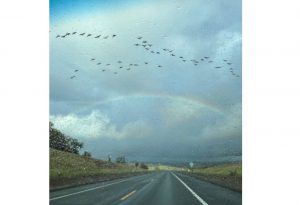Geese in the Garden
I have nostalgic recollections of geese. Years ago, on our five-acre farm in the San Joaquin valley, we purchased two African Grey goslings from a hatchery. When the drawer was opened, the first human they saw was me! I became their mother.
Those two geese would follow me everywhere, even when they matured. The big gander could be fierce but would back off when I came into the pen. (I did have to “rescue” a few people.)
The geese were large and very beautiful. They kept our yard mowed and gave us marvelous eggs both for eating and for Easter egg hunts! The expression on children’s faces when they came upon a colored goose egg was priceless.
We also raised “weeder” geese, all white with blue eyes. These made short work of weeds in the garden and were not quite as intimidating as the large Africans.
- Thomas Lanini, Extension Weed Ecologist at the University of California, talks about using geese in the garden as not a common method of weed control, but they have been used with trees, vines, and some annual crops such as cotton and strawberries. Geese can control Bermudagrass in organic orchards. The use of geese is a common topic on homesteader websites.
Recent Master Gardener columns have talked about end-of-year garden chores. Using geese to clean up your gardens at the end of the season can lessen your manual labor and you don’t have to worry about them eating young, tender, juicy vegetables as they might during the height of the season.
There are advantages to using geese: they do not compact soil, they will work seven days a week and they process weeds into nitrogen fertilizer. I find them to be engaging creatures. They are good watchdogs, making a racket when predators and people come around. And, they produce eggs – very large, dense eggs.
Geese need an enclosure, protection from the heat, and protection from predators such as dogs. They can easily be herded into a pen and will learn to go there at night. Generally, they just need someone to close the gate behind them. They need a water source for drinking (but if given a tub or pond, they will be swiming rather than eating your weeds).
One or two geese will suffice for an average size yard. A fence can keep them in the area you want to be weeded (or out of an area, as well). They prefer grasses but will eat almost anything if hungry. Young geese make the best weeders because, like most youth, they are hungry and growing. They are also not as distracted by sexual activity and fighting. Goslings need some protection from the elements, but by six weeks or less, they are ready and able to start weeding. (Keep an eye on them at the beginning to make sure they’re eating what you want them to eat.)
Geese require some daily maintenance; watering, feeding, moving, and fencing, plus they generate a large amount of ‘fertilizer.’ But, they are beautiful and loyal. And again, large colored goose eggs will make a big splash at any egg hunt!
Nancy Bliss is a University of California Cooperative Extension Master Gardener of Tuolumne County.
University of California Cooperative Extension Master Gardeners can answer gardening questions. In Tuolumne County call (209) 533-2912 and in Calaveras County call (209) 754-2880. You can fill out our easy-to-use problem questionnaire here. Check out our website here. You can also find us on Facebook.

